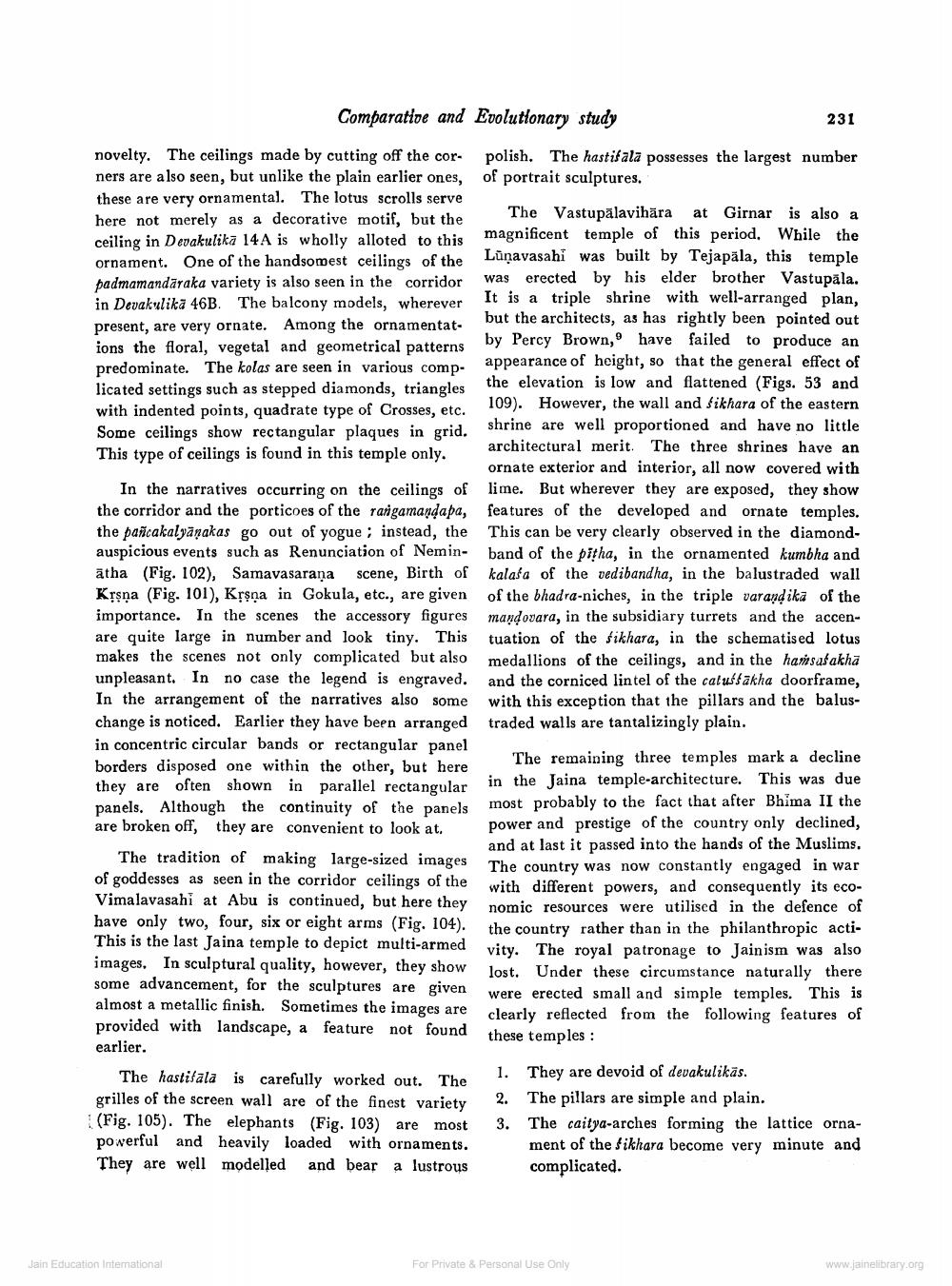________________
Comparative and Evolutionary study
novelty. The ceilings made by cutting off the corners are also seen, but unlike the plain earlier ones, these are very ornamental. The lotus scrolls serve here not merely as a decorative motif, but the ceiling in Devakulika 14A is wholly alloted to this ornament. One of the handsomest ceilings of the padmamandaraka variety is also seen in the corridor in Devakulika 46B. The balcony models, wherever present, are very ornate. Among the ornamentations the floral, vegetal and geometrical patterns predominate. The kolas are seen in various complicated settings such as stepped diamonds, triangles with indented points, quadrate type of Crosses, etc. Some ceilings show rectangular plaques in grid. This type of ceilings is found in this temple only.
In the narratives occurring on the ceilings of the corridor and the porticoes of the rangamandapa, the pañcakalyaṇakas go out of yogue; instead, the auspicious events such as Renunciation of Neminatha (Fig. 102), Samavasaraṇa scene, Birth of Kṛṣṇa (Fig. 101), Kṛṣṇa in Gokula, etc., are given importance. In the scenes the accessory figures are quite large in number and look tiny. This makes the scenes not only complicated but also unpleasant. In no case the legend is engraved. In the arrangement of the narratives also some change is noticed. Earlier they have been arranged in concentric circular bands or rectangular panel borders disposed one within the other, but here they are often shown in parallel rectangular panels. Although the continuity of the panels are broken off, they are convenient to look at.
The tradition of making large-sized images of goddesses as seen in the corridor ceilings of the Vimalavasahi at Abu is continued, but here they have only two, four, six or eight arms (Fig. 104). This is the last Jaina temple to depict multi-armed images. In sculptural quality, however, they show some advancement, for the sculptures are given almost a metallic finish. Sometimes the images are provided with landscape, a feature not found earlier.
The hastitala is carefully worked out. The grilles of the screen wall are of the finest variety (Fig. 105). The elephants (Fig. 103) are most powerful and heavily loaded with ornaments. They are well modelled and bear a lustrous
Jain Education International
polish. The hastifala possesses the largest number of portrait sculptures.
231
The Vastupalavihāra at Girnar is also a magnificent temple of this period. While the Lunavasahi was built by Tejapäla, this temple was erected by his elder brother Vastupala. It is a triple shrine with well-arranged plan, but the architects, as has rightly been pointed out by Percy Brown, have failed to produce an appearance of height, so that the general effect of the elevation is low and flattened (Figs. 53 and 109). However, the wall and sikhara of the eastern shrine are well proportioned and have no little
architectural merit. The three shrines have an ornate exterior and interior, all now covered with lime. But wherever they are exposed, they show features of the developed and ornate temples. This can be very clearly observed in the diamondband of the pitha, in the ornamented kumbha and kalafa of the vedibandha, in the balustraded wall of the bhadra-niches, in the triple varandika of the mandovara, in the subsidiary turrets and the accentuation of the fikhara, in the schematised lotus medallions of the ceilings, and in the hamsasakha and the corniced lintel of the catuffakha doorframe, with this exception that the pillars and the balustraded walls are tantalizingly plain.
The remaining three temples mark a decline in the Jaina temple-architecture. This was due most probably to the fact that after Bhima II the power and prestige of the country only declined, and at last it passed into the hands of the Muslims. The country was now constantly engaged in war with different powers, and consequently its economic resources were utilised in the defence of the country rather than in the philanthropic activity. The royal patronage to Jainism was also lost. Under these circumstance naturally there were erected small and simple temples. This is clearly reflected from the following features of these temples:
1.
2.
3.
They are devoid of devakulikäs.
The pillars are simple and plain.
The caitya-arches forming the lattice ornament of the Sikhara become very minute and complicated.
For Private & Personal Use Only
www.jainelibrary.org




